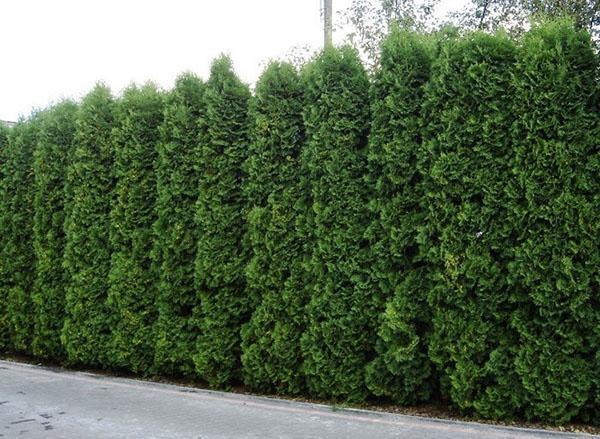Choosing varieties of thujas for hedges
 The hedge is gaining popularity in Russia. Many landscape designers use a green wall instead of a traditional fence in their projects. Plants that recover well after pruning are suitable for its formation. Winter hardiness and growth rate of seedlings are of no small importance.
The hedge is gaining popularity in Russia. Many landscape designers use a green wall instead of a traditional fence in their projects. Plants that recover well after pruning are suitable for its formation. Winter hardiness and growth rate of seedlings are of no small importance.
If you plant non-winter-hardy plants in the zone of risky agriculture, for example, in Siberia, then the hedge will suffer greatly: the leaves will fall off, and the shoots and the root system of the seedlings will freeze.
A quick restoration will help the hedge regain its decorative appearance after pruning, so it is better to plant plants that respond positively to formation.
The growth rate of seedlings affects the spacing between plants. The more the annual growth, the less plants are required. This saves you budget when setting up your hedge.
Thuja meets all these criteria. This tree is winter-hardy and hardy, so it is planted in regions with a cold climate in increments of 3 m to 5 m. There are more than 150 varieties of thuja. The most popular among them:
- Brabant;
- Emerald;
- Compact peramidalis;
- Columna.
All these varieties do not enter the stage of uncontrolled growth, which allows the hedge to be decorative for a long time. Let's consider these varieties in more detail.
Brabant
Thuja varieties Brabant in a single planting reaches 15 m in height. In a hedge, the tree grows up to 9 m. With good watering, the annual growth is 50 cm. Thuja grows more modestly in width: by 10-15 cm per year.
Emerald
Unlike others varieties of Smaragd retains a dark green color in winter. In a hedge, the tops of the trees do not close. Trees grow much slower than Brabant.
Use Smaragd in compositions with ornamental shrubs. These trees also look great in single plantings.
Compact peramidalis
This variety got its name because of the pyramidal crown. It is considered the most suitable for hedges. Tui Peramidalis compacta reach 5 m in height.
Western Columna
Western Columna is the most promising variety for hedges. The trees grow up to 9 m in height. The annual growth is 20 cm.The tree has a very narrow crown, therefore, the planting step when forming a hedge should be reduced to 1 m.If you plant them at a great distance, you can get a look similar to cypresses Tuscany.